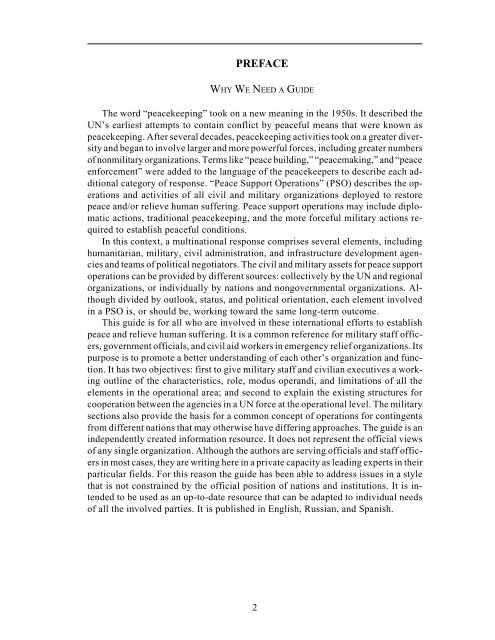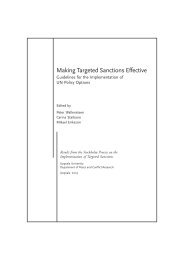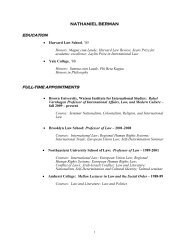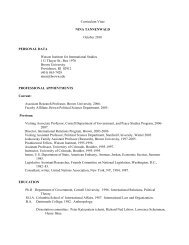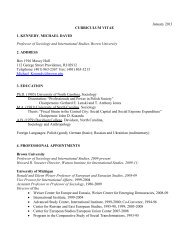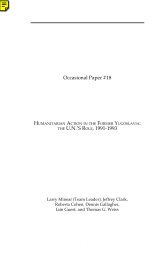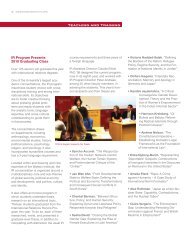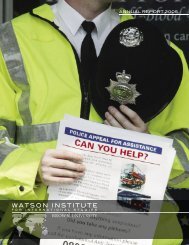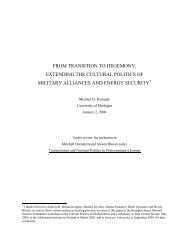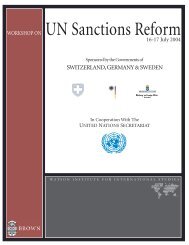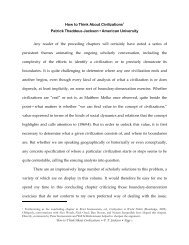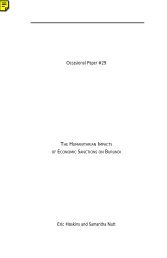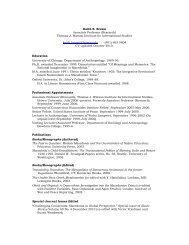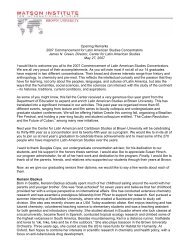a guide to peace support operations - The Watson Institute for ...
a guide to peace support operations - The Watson Institute for ...
a guide to peace support operations - The Watson Institute for ...
You also want an ePaper? Increase the reach of your titles
YUMPU automatically turns print PDFs into web optimized ePapers that Google loves.
PREFACE<br />
WHY WE NEED A GUIDE<br />
<strong>The</strong> word “<strong>peace</strong>keeping” <strong>to</strong>ok on a new meaning in the 1950s. It described the<br />
UN’s earliest attempts <strong>to</strong> contain conflict by <strong>peace</strong>ful means that were known as<br />
<strong>peace</strong>keeping. After several decades, <strong>peace</strong>keeping activities <strong>to</strong>ok on a greater diversity<br />
and began <strong>to</strong> involve larger and more powerful <strong>for</strong>ces, including greater numbers<br />
of nonmilitary organizations. Terms like “<strong>peace</strong> building,” “<strong>peace</strong>making,” and “<strong>peace</strong><br />
en<strong>for</strong>cement” were added <strong>to</strong> the language of the <strong>peace</strong>keepers <strong>to</strong> describe each additional<br />
category of response. “Peace Support Operations” (PSO) describes the <strong>operations</strong><br />
and activities of all civil and military organizations deployed <strong>to</strong> res<strong>to</strong>re<br />
<strong>peace</strong> and/or relieve human suffering. Peace <strong>support</strong> <strong>operations</strong> may include diplomatic<br />
actions, traditional <strong>peace</strong>keeping, and the more <strong>for</strong>ceful military actions required<br />
<strong>to</strong> establish <strong>peace</strong>ful conditions.<br />
In this context, a multinational response comprises several elements, including<br />
humanitarian, military, civil administration, and infrastructure development agencies<br />
and teams of political negotia<strong>to</strong>rs. <strong>The</strong> civil and military assets <strong>for</strong> <strong>peace</strong> <strong>support</strong><br />
<strong>operations</strong> can be provided by different sources: collectively by the UN and regional<br />
organizations, or individually by nations and nongovernmental organizations. Although<br />
divided by outlook, status, and political orientation, each element involved<br />
in a PSO is, or should be, working <strong>to</strong>ward the same long-term outcome.<br />
This <strong>guide</strong> is <strong>for</strong> all who are involved in these international ef<strong>for</strong>ts <strong>to</strong> establish<br />
<strong>peace</strong> and relieve human suffering. It is a common reference <strong>for</strong> military staff officers,<br />
government officials, and civil aid workers in emergency relief organizations. Its<br />
purpose is <strong>to</strong> promote a better understanding of each other’s organization and function.<br />
It has two objectives: first <strong>to</strong> give military staff and civilian executives a working<br />
outline of the characteristics, role, modus operandi, and limitations of all the<br />
elements in the operational area; and second <strong>to</strong> explain the existing structures <strong>for</strong><br />
cooperation between the agencies in a UN <strong>for</strong>ce at the operational level. <strong>The</strong> military<br />
sections also provide the basis <strong>for</strong> a common concept of <strong>operations</strong> <strong>for</strong> contingents<br />
from different nations that may otherwise have differing approaches. <strong>The</strong> <strong>guide</strong> is an<br />
independently created in<strong>for</strong>mation resource. It does not represent the official views<br />
of any single organization. Although the authors are serving officials and staff officers<br />
in most cases, they are writing here in a private capacity as leading experts in their<br />
particular fields. For this reason the <strong>guide</strong> has been able <strong>to</strong> address issues in a style<br />
that is not constrained by the official position of nations and institutions. It is intended<br />
<strong>to</strong> be used as an up-<strong>to</strong>-date resource that can be adapted <strong>to</strong> individual needs<br />
of all the involved parties. It is published in English, Russian, and Spanish.<br />
2


